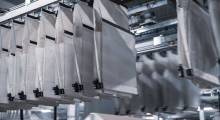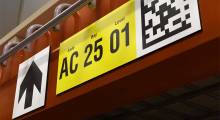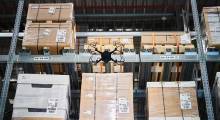Warehouses and DCs have traditionally relied on barcodes to track inventory, but there’s a new kid on the block: radio frequency identification (RFID). In this Leader’s Q&A, Bryan Ferguson, market product manager at SICK, Inc., discusses the resurgence of RFID technology, how it’s evolved over the years and how it’s been successfully applied in material handling environments.
Q: How has RFID evolved in recent years?
A: In the past, the cost of an RFID tag didn’t align with the return on investment (ROI). Also, RFID readers couldn’t easily integrate into industrial applications nor support standard industrial communication protocols. Finally, the number of RFID-savvy individuals needed to integrate and to support RFID programs was limited.
Q: What’s different now?
A: Tag prices have dropped and tag technology itself has improved. The RFID solutions themselves are also more industrial-friendly and feature designs that have evolved to support the requirements of harsh industrial environments. Also, harvesting the data from an RFID tag and then sharing that data across a network is much easier today thanks to intelligent RFID readers with onboard data processing and flexible communication options. RFID readers are now available to support multiple communication protocols, so integration into networks and control devices is much easier today.
Q: What challenges does RFID solve?
A: The technology provides very specific visibility into exactly where a pallet or bulk load of material is located. Companies waste a tremendous amount of money, resources and time dealing with materials that aren’t where they’re supposed to be. Maybe a shipment wasn’t loaded onto the correct tractor trailer, or maybe it was misplaced in the warehouse. Today’s RFID solutions overcome these challenges by providing, 1) clear visibility into the location and 2) confirmation of movement of material within the organization.
Q: What are some future RFID trends that SICK is tracking this year?
A: We’re seeing more large retailers defining timelines and handing down new RFID mandates to their suppliers. Companies that have been considering RFID now have a major influence from the customer side that’s supporting them. I think their understanding of RFID and the benefits it provides parlay into additional RFID projects within an organization. For instance, we recently worked with a supplier to deploy RFID solutions in production lines to confirm tag functionality and tag data. After a successful RFID deployment in production, the company decided to use an RFID bulk reading solution to resolve lost or misplaced inventory. The company was losing up to 30% of its inventory throughout the distribution process. Using RFID, the company has been able to significantly reduce those double-digit inventory losses.
Q: How else is SICK helping companies leverage the power of RFID in the warehouse?
A: We’ve developed an all-in-one solution that includes an antenna, controller and communication ports right in the RFID reader. We also offer an application layer through SICK AppSpace, which takes data and formats it across multiple protocols (i.e., MQTT, OPC, IO link or cloud networks). The software configuration is included in the price of the device and doesn’t require any additional programming or control devices. As well, our free configuration software provides filtering and return signal strength visibility to overcome RFID reflections and overshoots - typical challenges in an industrial application.
Most importantly, SICK offers field application engineers and turnkey installation services to support our RFID hardware.
Article topics










